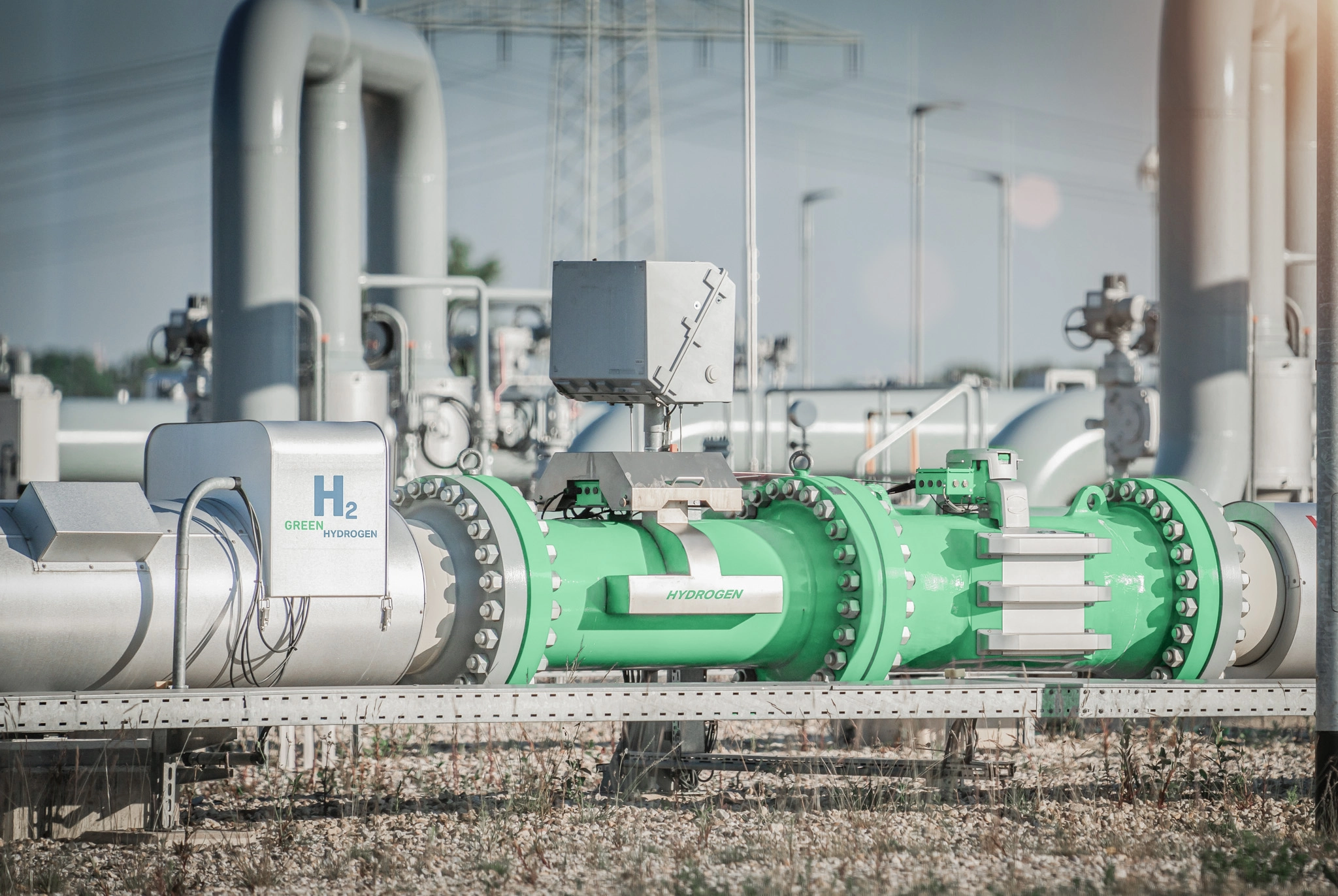Hydrogen produced using renewable energy sources such as water, wind and solar could reduce a large proportion of today’s carbon dioxide emissions and imported goods such as petrol and fertilisers.
Where is hydrogen?
Hydrogen (H) is the lightest element known. Although hydrogen is the most abundant element in the universe, it is rarely found on Earth. This is because hydrogen is highly reactive and readily attaches itself to other elements. We find it in bonds like water (H2O) and methane (CH4), two very common bonds.
What is hydrogen?
Hydrogen (H2) is formed when two hydrogen atoms combine. Hydrogen assumes gaseous form at very low temperature. To store hydrogen gas in liquid form, the gas needs to be cooled down to -253 degrees Celsius. It is also possible to store hydrogen in containers with a high air pressure (200-700 bar).
How can hydrogen affect the climate?
Energy is used to produce hydrogen, but hydrogen can also be used to create energy.
There are different methods of producing hydrogen and depending on how hydrogen is made, it takes on different colours. To produce green hydrogen, renewable electricity and water (H2O) are needed. The production is then done by electrolysis (see description below).
The most common way of extracting hydrogen at the moment is by steam reforming natural gas and biogas containing methane. When the water vapour reacts with the methane, carbon dioxide and hydrogen gas are formed. This type of hydrogen is often referred to as grey or blue. The disadvantage is that this process involves some carbon dioxide emissions.
This is why green hydrogen is identified as an important part of the global societal transition and humanity’s climate impact.
Both societal benefits and business opportunities are predicted to increase if green hydrogen is used. Much because it is seen as both an energy carrier(a substance or system that stores and transports energy, rather than being an energy source) and commodity that can be included in industry, transport, agriculture, real estate and energy.
What is electrolysis?
An electrolyser splits hydrogen and oxygen. The process has been used for over a hundred years in industry. An electrolyser can produce hydrogen when electricity is plentiful and reduce production when less electricity is available. In this way, the grid is balanced.
The electrolysis process also creates oxygen (O2), which can be used in industry or healthcare, for example. The amount of renewable hydrogen that can be produced by electrolysis is limited by the amount of renewable electricity that can be produced.
In northern Sweden, there is plenty of renewable energy, which means that we have the opportunity to produce large amounts of green hydrogen, which is one of the reasons why H2 Green Steel has chosen to make its 50 billion investment in Boden.
The disadvantage is that the efficiency is relatively low, about 20-30% of the energy content is lost in the conversion from electricity to hydrogen. However, research and development is ongoing to improve efficiency.
By 2030, it is estimated that losses could be reduced to between 14 and 18%.
How can hydrogen be used in industry?
Today, hydrogen is mainly used as a raw material in the chemical industry. But thanks to increasing demands to phase out fossil fuels, hydrogen could become central to many new activities to replace fossil energy. For example, the steel industry is investing heavily in replacing coal and coke with hydrogen in the process of removing oxygen from iron ore. The advantage of using hydrogen is that the by-product of this production is water (H2O).
In the chemical and refining industries, too, hydrogen is a prerequisite for reducing carbon dioxide emissions, and several projects are under way in this area.
How can hydrogen be used in vehicles?
By 2030, transport in Sweden will be fossil-free.
To reach that goal, the industry is expected to need to be electrified. One solution the industry is looking at is fuel cell vehicles. In simple terms, the fuel cell vehicle has an electric motor, fuel cell and hydrogen tank. Hydrogen is filled up as in a traditional refuelling. It then reacts with air in the fuel cell to create electricity, which in turn powers the electric motor and drives the vehicle. Nothing but water vapour comes from the exhaust pipe.
Hydrogen can be used for cars, trucks, buses, planes, trains or ships.
So far, the use of hydrogen in transport has been limited. But as the cost of renewable energy and technology, among other things, falls, infrastructure is slowly being built out.
How can hydrogen be used in the energy sector?
The energy sector is also moving towards fossil-free energy through electrification in several activities. With an increasing share of renewable electricity generation, there is a growing need for flexible solutions to balance the energy system depending on how much wind there is or whether the sun is shining.
Electricity producers are interested in hydrogen because it can be reused to create new energy.
To turn hydrogen into electricity or heat, a fuel cell, internal combustion engine or gas turbine is needed. As electricity cannot be stored, there is an opportunity for electricity generators to supply stored hydrogen during times when renewable electricity is less available and produce hydrogen when electricity is available.
Excess heat produced by hydrogen production can also be used to heat buildings or surfaces.
How can hydrogen be used in agriculture?
The goal in the agricultural sector is to become 100% fossil free in fuels, drying and heating by 2030. It also means phasing out the use of fossil fuel-based fertilisers. Today, ammonia is widely used in the production of fertilisers. The chemical is usually produced with hydrogen from fossil sources such as natural gas, coal and oil, which are imported to Sweden. Instead, it is now looking at using local green hydrogen from renewable energy sources.
Fertiberia is a company that has plans to do just that in Boden and Luleå.
How can hydrogen be used in buildings?
The construction and real estate sector’s climate target is to achieve a 50% reduction in emissions in the construction sector by 2030 and to be fossil-free by 2045.
Hydrogen production by electrolysis generates heat that can be used to heat a building, an area or fed into the district heating network. Hydrogen gas can be used to store renewable energy from, for example, solar cells on the roof, to be used to heat the property in winter when the sun is not shining as brightly. There are several completed projects in self-sufficient buildings.
How can hydrogen be used in emergency preparedness?
If for some reason the grid is unable to supply electricity, hydrogen can be used, with the help of fuel cell technology, to generate emission-free back-up power. Today, backup power is based on diesel or other fossil fuels.
Backup power is currently used for critical functions where electricity supply is critical. Hospitals, water treatment plants, server halls and telephone exchanges. Properties with back-up power can be used by authorities in an emergency situation.
How dangerous is hydrogen?
Hydrogen is highly flammable, but because hydrogen is the lightest element in the universe, it quickly dissipates into the atmosphere. The time at which hydrogen could ignite is therefore very short.
As a pressurised gas, the handling of hydrogen needs to follow clear guidelines and be carried out by trained personnel. The main risks associated with hydrogen are concentrated mainly in storage.
However, the probability of a serious accident in hydrogen storage is low. H2 Green Steel has previously commented on the risk of an explosion at 1 in 283,000. The distance between their hydrogen plant and other buildings is also within the safety margins required for storing hydrogen.
Watch an earlier interview with Håkan Nordin, Business Developer at Boden Business Agency, and Kajsa Ryttberg-Wallgren, Head of Hydrogen Business Area at H2 Green Steel.


